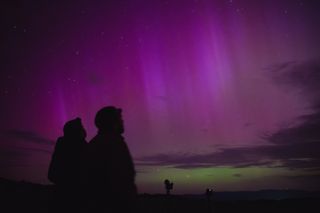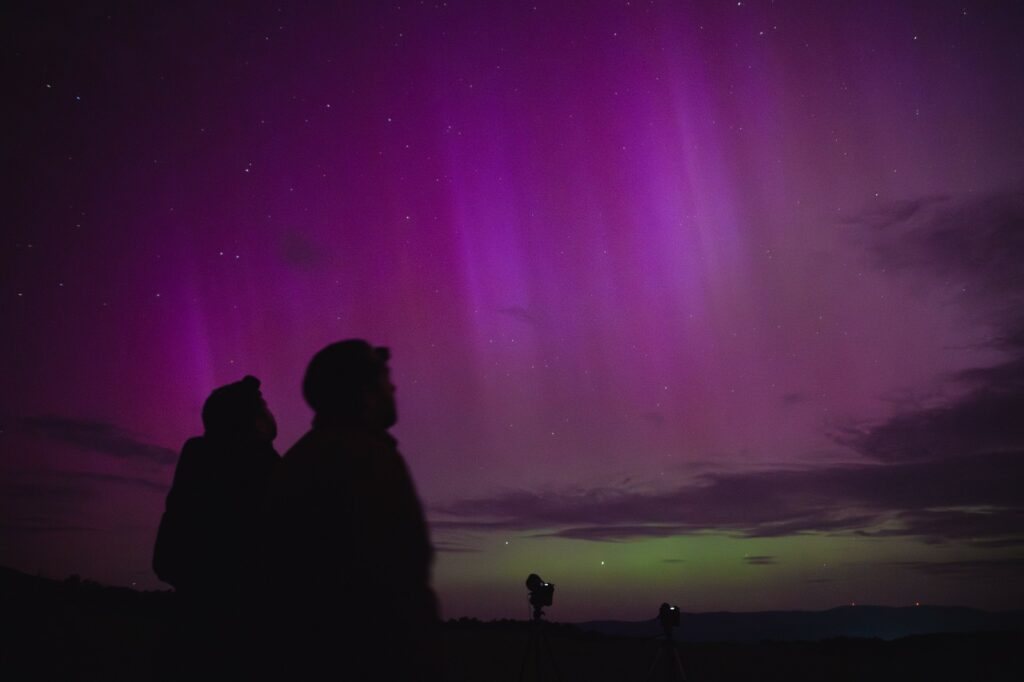
The northern lights (Aurora Borealis), also known as aurora, colorful lights shift, illuminate the sky in Debrad, Slovakia, May 11, 2024. They should continue globally on May 12 for Mother’s Day.
(Image credit: Robert Nemeti/Anadolu via Getty Images)
Want to save all the calories from Mother’s Day brunch? You may still be able to “sweeten” the holiday with a view of the ramped-up northern lights again tonight (May 12)!
Plasma from a powerful solar eruption called a coronal mass ejection (CME) slammed into Earth on Friday (May 10), sparking an intense geomagnetic storm. One of the effects was a supercharged northern lights display, which provided skywatchers in much of the U.S. and other regions around the world with absolutely mesmerizing aurora views over the weekend.
“The aurora may become visible over much of the northern half of the country, and maybe as far south as Alabama and northern California,” officials with NOAA’s Space Weather Prediction Center (SWPC) wrote in a weekend update, adding that “severe and extreme” geomagnetic storms were likely again Sunday night.
And the show could continue tonight; another CME launched from the super sunspot region AR3664 is expected to approach Earth by midday. The result could be more rounds of severe to extreme geomagnetic storms — G4 to G5 on the space weather scale devised by the U.S. National Oceanic and Atmospheric Administration (NOAA) — into the evening and perhaps into Monday (May 13).
“It takes an extraordinary CME to produce G5 conditions,” Bill Murtagh, program coordinator for NOAA’s SWPC, told Space.com in a phone interview. “We’re expecting a decent impact from the CME tomorrow [Sunday]. It was just a little bit further from the limb [edge] of the sun, but still good enough that it should give us a good hit. And if everything couples right, we could certainly see the sky lit up again.”
Related: When and where to see the northern lights
Space.com Reference Editor Daisy Dobrijevic captured this view of the northern lights from Nottingham, U.K. on May 10, 2024.(Image credit: Daisy Dobrijevic)
Space.com Reference Editor Daisy Dobrijevic captured this view of the northern lights from Nottingham, U.K. on May 10, 2024.(Image credit: Daisy Dobrijevic)
Skywatcher Kaitlin Moore captured this photo of the May 2024 auroras over Lake Mendota near Madison, Wisconsin on May 10, 2024.(Image credit: Kaitlin Moore)
Skywatcher Kaitlin Moore captured this photo of the May 2024 auroras over Lake Mendota near Madison, Wisconsin on May 10, 2024.(Image credit: Kaitlin Moore)
Skywatcher Kaitlin Moore captured this photo of the May 2024 auroras over Lake Mendota near Madison, Wisconsin on May 10, 2024.(Image credit: Kaitlin Moore)
Space.com Editor Brett Tingley snapped this photo of the northern lights from Greer, South Carolina on May 10, 2024.(Image credit: Brett Tingley)
Space.com Editor Brett Tingley snapped this photo of the northern lights from Greer, South Carolina on May 10, 2024.(Image credit: Brett Tingley)
(Image credit: Daisy Dobrijevic)
While boosted auroras are quite a treat, extreme (G5) geomagnetic storms can also have negative effects. From the conditions observed at the beginning of the weekend, irregularities have been reported to power grids as well as some degradation to GPS and high-frequency communications.
Breaking space news, the latest updates on rocket launches, skywatching events and more!
“When the CME arrives and carries its own magnetic field, depending on how that interacts with Earth’s magnetic field, that magnetic field can fluctuate. When you superimpose that over long conductors, things like pipelines and railroad tracks and power lines, it can induce current,” Rob Steenburgh, a space scientist at NOAA’s Space Weather Prediction Center (SWPC), said in a teleconference on Friday.
“That electrical current is not supposed to be there, and so our role is to alert the operators of these different systems so that they’re aware and can take actions to mitigate these kinds of impacts,” he added.
Check out the SWPC’s experimental aurora viewline for a map of the US to see where the likelihood remains elevated this evening.
Related: The worst solar storms in history
This weekend’s extreme auroras and geomagnetic storms come as the sun is in a particularly active phase of its 11-year weather cycle, which scientists call the solar cycle. Currently, the sun is approaching a period called solar maximum, when solar activity peaks for the current Solar Cycle 25, which is expected to begin in mid-2024.
If you’re hoping to capture the Mother’s Day auroras for yourself, our guide on how to photograph the northern lights can help, and you may want to check out our recommendations for the best equipment for aurora photography and how to edit aurora photos to prepare for the next solar storm event. If you’re just hoping to see the spectacle, don’t miss our guide on how to see the northern lights.
Editor’s note: If you capture a stunning photo or video of the northern lights (or southern lights!) and want to share them with Space.com for a possible story, send images, comments on the view and your location, as well as use permissions to spacephotos@space.com.
Join our Space Forums to keep talking space on the latest missions, night sky and more! And if you have a news tip, correction or comment, let us know at: community@space.com.
Meredith is a regional Murrow award-winning Certified Broadcast Meteorologist and science/space correspondent. She most recently was a Freelance Meteorologist for NY 1 in New York City & the 19 First Alert Weather Team in Cleveland. A self-described “Rocket Girl,” Meredith’s personal and professional work has drawn recognition over the last decade, including the inaugural Valparaiso University Alumni Association First Decade Achievement Award, two special reports in News 12’s Climate Special “Saving Our Shores” that won a Regional Edward R. Murrow Award, multiple Fair Media Council Folio & Press Club of Long Island awards for meteorology & reporting, and a Long Island Business News & NYC TV Week “40 Under 40” Award.
>>> Read full article>>>
Copyright for syndicated content belongs to the linked Source : Space.com – https://www.space.com/sun-storms-aurora-show-mothers-day-2024
